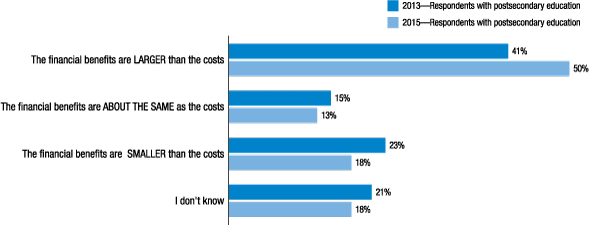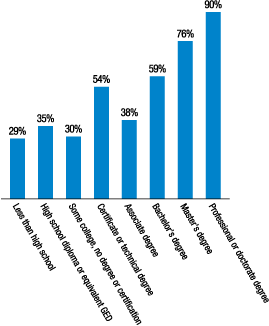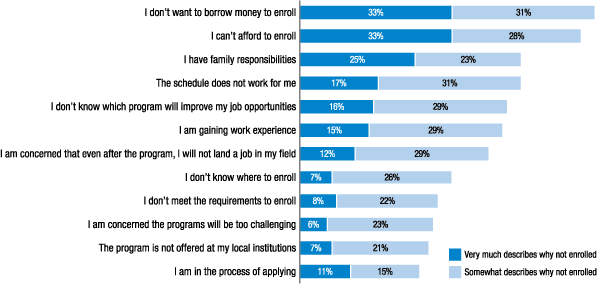Experiences and Perspectives of Young Workers
Value of Education
Whether an individual obtains postsecondary education and completes a certificate or degree has long been understood to be a major determinant of labor market outcomes and financial self-sufficiency. College enrollment has been growing nationwide. However, as college costs and the percentage of students borrowing to pay for education both continue to rise, many young adults must attempt to measure the value of education in the labor market. The survey asks respondents about their educational experience, their perceptions of the value of their degree, and, among those who believe they need more education, why they did not continue their education.
Profile of Current Students
In the 2015 survey, 28 percent of respondents are enrolled in an educational or training program. This marks a slight decrease from the 2013 enrollment of 32 percent (table 17). The survey respondents' decrease in enrollment coincides with a 1.3 percent decrease in postsecondary enrollment nationally between spring 2015 and spring 2016.23
| Response | 2013 | 2015 |
|---|---|---|
| Yes ("students") | 32 | 28 |
| No | 67 | 72 |
| Number of responses | 2,097 | 2,035 |
In the 2015 survey, most students enrolled in degree programs, including associate's degrees (23 percent), bachelor's degrees (55 percent), and graduate degrees (9 percent). Eight percent of the students are enrolled in a certificate or technical degree program. And, 4 percent of the students are not enrolled in postsecondary studies, as they are working to obtain their high school diploma or high school equivalent rather than a postsecondary credential.
The 2015 survey data were analyzed to describe the "traditional" or "nontraditional" characteristics to describe the current postsecondary, undergraduate population and to be able to monitor shifts going forward. The National Center for Education Statistics (NCES) describes the characteristics of "nontraditional" postsecondary students by: (1) enrollment patterns (enroll immediately after high school, full-time enrollment); (2) financial and family status (working full time, dependents or single parent, financially independent); and (3) high school graduation status (lack a high school diploma).
First, nontraditional students may be identified by their enrollment patterns by age, including when there is a lag between high school graduation and their postsecondary enrollment. In this report, traditionally aged students were identified as respondents between ages 18 and 20 years old who are enrolled in a certificate or technical degree program or associate's degree program as well as respondents between 18 and 23 years who are enrolled in a bachelor's degree program. By this definition, 60 percent of the students are traditionally aged and 40 percent are nontraditionally aged (table 18).
| Education level | Age in years | ||||||
|---|---|---|---|---|---|---|---|
| 18 | 19 | 20 | 21 | 22 | 23 | 24 + | |
| High school diploma or equivalent GED | 1 | 0 | 0 | 0 | 0 | 0 | 2 |
| Certificate or technical degree | 1 | 0 | 0 | 1 | 1 | 0 | 4 |
| Associate degree | 5 | 4 | 4 | 3 | 2 | 1 | 5 |
| Bachelor's degree | 6 | 11 | 10 | 9 | 6 | 4 | 10 |
| Master's, professional, or doctorate degree | 0 | 0 | 0 | 0 | 1 | 1 | 7 |
Note: Number of responses is 478. "Traditionally aged" students (indicated in bold) represent 60 percent and "nontraditionally aged" students represent 40 percent of current students.
Furthermore, nontraditional students may be identified by their enrollment status, that is, those who are not enrolled full time. In the survey, 73 percent of students are enrolled full time and 26 percent of students are enrolled part time. Students in bachelor's degree programs are the most likely to be full-time students (89 percent). Meanwhile, 60 percent of students enrolled in associate's degree programs and 33 percent of students enrolled in certificate and technical degree programs are enrolled full time (table 19).
| Student characteristics | Total | Type of certificate or degree program enrolled in | ||
|---|---|---|---|---|
| Certificate or technical degree | Associate's degree | Bachelor's degree | ||
| Enrollment patterns (status) | ||||
| Full time | 73 | 33 | 60 | 89 |
| Part time | 26 | 61 | 39 | 11 |
| Financial status (work status) | ||||
| Full-time, paid employee | 20 | 31 | 17 | 15 |
| Part-time, paid employee | 44 | 28 | 53 | 46 |
| Not paid employee | 36 | 41 | 30 | 39 |
| Financial status (receive assistance from parents or other family members for living situation) |
||||
| Receive assistance | 66 | 66 | 76 | 68 |
| Do not receive assistance | 33 | 30 | 24 | 32 |
| Number of respondents | 478 | 36 | 106 | 230 |
Note: Small sample size for certificate and technical degree students.
Second, the NCES identifies nontraditional students by financial and family status including working full time. In the survey, 64 percent of students have a paid job, including 20 percent of all students with a full-time job. Students enrolled in a certificate or technical degree program are the most likely to be working full time (31 percent). Students enrolled in an associate's degree or a bachelor's degree program are less likely to work full time (17 percent and 15 percent, respectively) (table 19).
Nontraditional students' financial and family status can also be identified by dependent children or financial independence. The Survey of Young Workers does not ask about respondents' dependent children. However, the survey does ask whether respondents receive financial assistance from parents or other family members for their living situation. Overall, 66 percent of students in the survey receive financial assistance for their living situation. Students enrolled in an associate's degree program are more likely to receive assistance for their living situation (76 percent) than those enrolled in a certificate or technical degree program (66 percent) or those enrolled in a bachelor's program (68 percent) (table 19). Please note, students enrolled in an associate's degree program are also more likely to be under 21 years of age than those in other educational programs.
Finally, the NCES identifies nontraditional postsecondary students as those who did not receive a high school diploma. The survey did not ask respondents whether they received a high school diploma.
Non-completers
Withdrawing from an educational program prior to earning a certificate or degree leaves these "non-completers" more vulnerable to poor labor market outcomes than those who complete their educational investment with a certificate or degree. In the survey, 10 percent of respondents are non-completers, identified as those who are not currently enrolled in a certificate or degree program they started.
Among non-completers, 28 percent withdrew from their educational or training program less than one year ago, 32 percent withdrew one to two years ago, and 37 percent withdrew more than two years ago. The remaining 3 percent do not recall when they were last enrolled in their program.
Most non-completers intend to re-enroll and complete the certificate or degree program they started. More specifically, 41 percent say they will "definitely" complete the program, and 20 percent say they will "probably" complete the program. Meanwhile, 25 percent of non-completers are not sure if they will complete the program they started. Finally, some will "probably not" (5 percent) or "definitely not" (9 percent) complete the certificate or degree program.
Financing Postsecondary Education
Among young adults who obtain postsecondary education, it is increasingly common that at least a portion of their education will be financed through a student loan or other forms of borrowing. The survey asks respondents with postsecondary experience about how they financed their most recent educational experience.
Respondents reported four primary sources for financing their most recent educational experience. First, 62 percent of respondents with postsecondary education worked while in school to finance all or part of their most recent education. Second, 52 percent of respondents have parents who contributed to educational costs. Respondents were not asked to specify whether their parents used loans, savings, or other resources for their contributions. Third, 46 percent received used financial-aid based grants (including Pell Grants and Free Application for Federal Student Aid (FAFSA) loans) to pay for their postsecondary education.24 Fourth, 46 percent of respondents also used financial-aid-based loans (including FAFSA loans) to finance their most recent postsecondary educational program (figure 7).
Figure 7. Please indicate whether you used any of the following forms of financing for your most recent educational program

On a smaller scale, 39 percent of students received an academic scholarship to finance all or part of their most recent educational experience. Thirty-eight percent of respondents used their own savings to pay for their most recent educational experience. Finally, 10 percent of respondents used tuition reimbursement from an employer (including military) to pay for their education (figure 7).
When asked about their total postsecondary educational experience (rather than their most recent), 36 percent of respondents incurred some debt to pay for their education. Students with higher levels of educational attainment are more likely to have used debt to finance some portion of their education. Notably, 42 percent of those with a certificate or technical degree used debt to finance their education compared with 57 percent of respondents with a bachelor's degree and 67 percent of respondents with a graduate degree.
Value of Postsecondary Education
In order to examine the perceived value of higher education, the survey asks respondents with postsecondary educational experience whether they believe the financial benefits of their most recent postsecondary experience outweigh the costs. The survey aims to assess whether respondents perceive this value by asking if they believe they have the level of education they need for the type of job they would like to hold.
Between 2013 and 2015, there was an increase in the percent of respondents (from 41 percent to 50 percent) who believe the financial benefits of their most recent educational program are larger than the costs. Likewise, there was a decrease in the percent of respondents (from 23 percent to 18 percent) who believe that the financial benefits of their most recent educational program are smaller than the costs
(figure 8).

In the analysis of the 2013 data, respondents who had incurred debt to pay for their education were less likely to report that the financial benefits of their most recent educational experience were larger than the costs of those who did not incur debt. However, the analysis of the 2015 data did not support this finding. Similarly, in 2015, there was no correlation between the value placed on education between certificate/degree holders and non-completers, respondents with a job and those without a paid job, or respondents with a temporary and permanent job.
Additional Educational Attainment
Overall, 41 percent of respondents believe they have the level of education and training needed for the type of job that they would like to hold in the next five years. Respondents with a graduate degree are the most likely to believe they have the necessary level of education (76 percent of master's degree and 90 percent for professional or doctorate degree).25 Respondents with a certificate or technical degree or a bachelor's degree also show a moderate degree of confidence in their level of education (54 percent and 59 percent, respectively). Those who lack postsecondary credentials are much less likely to believe they have the necessary level of education (29 percent with less than high school education, 35 percent with high school, and 30 percent with some college)
(figure 9).
Figure 9. Believe to have the level of education and training needed for the type of job that you would like to hold in the next five years

Barriers to Postsecondary Education
The survey probed respondents who are not currently enrolled in an educational program, but who are interested about barriers to postsecondary enrollment. The cost of postsecondary education is the most frequently cited reason for not enrolling in postsecondary education. More specifically, 33 percent of these respondents said "I don't want to borrow money to enroll" very much describes why they are not enrolled, and 31 percent said "I don't want to borrow money to enroll" somewhat describes why they are not enrolled. Similarly, 33 percent reported that "I cannot afford to enroll" very much describes why they are not enrolled, and 28 percent said this statement somewhat describes why they are not enrolled (figure 10).
Figure 10. How much each reason describes why you are not enrolled (among those who are interested in additional education but are not currently enrolled)

For many respondents, time and schedule are also barriers to enrollment in additional education. Twenty-five percent report that "family responsibilities" very much describe why they are not enrolled, and 23 percent report family responsibilities somewhat describes their reason(s). Seventeen percent said that the program's schedule very much describes why they are not enrolled, and 31 percent said this somewhat describes the reason (figure 10).
Additional reasons that describe why many respondents who are interested in additional information but are not enrolled include "I don't know which program will improve my job opportunities," "I am gaining work experience," and "I am concerned that even after the program, I will not land a job in my field" (figure 10).
Finally, reasons that had less impact on enrollment than those already mentioned include "I don't know where to enroll," "I don't meet the requirements to enroll," "I am concerned the programs will be too challenging," and "the program is not offered at my local institutions" (figure 10).
Related Research on the Value of Education
Although unemployment rates and wages stagnated in the immediate aftermath of the Great Recession, workers with postsecondary credentials continued a longstanding trend of faring better in the labor market than the general population. Carnevale, Jayasundera, and Gulish (2015) found that since the end of the Great Recession, the number of jobs held by college graduates has steadily increased while jobs held by workers with a high school diploma or less have shown virtually no recovery.26
In order to meet the demand for postsecondary credentials, young adults are increasingly enrolling in certificate and vocational training, in addition to traditional institutions of higher education. Carnevale, Jayasundera, and Cheah (2012) found that the number of individuals obtaining certificates more than tripled between 1994 and 2010 and that one in 10 workers now report a certificate as their highest level of education. Likewise, on average, certificate holders earn 20 percent more than high school graduates without any postsecondary education.27
References
23. National Student Clearinghouse Research Center, 2016, Term Enrollment Estimates: Spring 2016. See https://nscresearchcenter.org/wp-content/uploads/CurrentTermEnrollment-Spring2016.pdf ![]() . Return to text
. Return to text
24. The Free Application for Federal Student Aid (FAFSA) is a part of the U.S. Department of Education and is the largest provider of student financial aid in the nation. See https://fafsa.ed.gov/. Return to text
25. Sample size for respondents with a master's degree and with a doctorate or professional degree is small. Return to text
26. Anthony Carnevale, Tamara Jayasundera, and Artem Gulish, Six Million Missing Jobs: The Lingering Pain of the Great Recession (Washington: Georgetown University: Center on Education and the Workforce, 2015), https://cew.georgetown.edu/wp-content/uploads/Six-Million-Missing-Jobs.pdf ![]() . Return to text
. Return to text
27. Carnevale, Jayasundera, and Cheah, The College Advantage. Return to text
